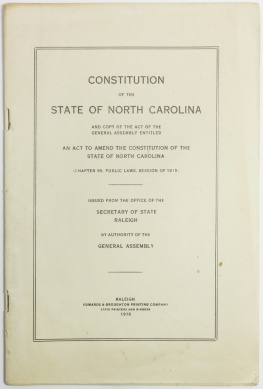THE NEGRO AND FUSION POLITICS
IN NORTH CAROLINA
18941901
Copyright, 1951, by
The University of North Carolina Press
Copyright renewed, 1979, by Helen G. Edmonds
Manufactured in the United States of America
THIS BOOK WAS DIGITALLY MANUFACTURED.
To
MR. AND MRS. JAMES H. CARTER
whose generosity inspired me in
my college days.
Acknowledgments
THE HUMBLEST ATTEMPT at historical writing finds an author indebted to the present and the past, to the living and the dead. While bibliographical references herein cited bear mute recognition of the debt of gratitude to some, I want and must express my obligation to a number of individuals whose help has gone beyond the ordinary courtesy of formal response.
My sincere thanks are expressed to Dr. Albert N. Newsome and Dr. Hugh T. Lefler, Chairman of the Department and Professor of History, respectively, University of North Carolina, who offered important suggestions in matters of detail and general organization for the improvement of this work. They read the many revisions in their entirety with a critical eye and helpful spirit. Dr. Henry H. Simms, Associate Professor of History at Ohio State University, offered many discriminating criticisms which were invaluable. It was in his classes that I became inspired, my historical insight enriched, and my attention focused on Southern history. I am indebted to Dr. John Hope Franklin, Professor of History, Howard University, and Mr. J. MacLeod, Department of History, University of North Carolina, for their time in reading parts of this manuscript which fell within their particular areas of research. While this work was read and advised by these scholars, it is to be understood, however, that I absolve them from the responsibility for any errors which may have crept into it.
I am grateful for the cooperative and courteous services rendered me personally by the staffs of the libraries of Duke University, North Carolina College at Durham, the University of North Carolina, North Carolina State Department of Archives and History, North Carolina State Library, and Congress. Mrs. Parepa W. Jackson, former Librarian, North Carolina College at Durham, reduced the necessity of some travel thereby minimizing expense by assembling some materials through inter-library loan. Miss Helen Oyler of Duke University Library provided a cordial academic atmosphere for the use of those materials which could not be taken from a library. I am equally anxious to pay some tribute to my sister-in-law, Mrs. Rebecca Palmer Edmonds, for laborious hours of retyping and helpful suggestions.
Persons interviewed are thanked for their time and the rendition of their experiences. It is my hope that they will not be shocked by the omission of some of their contributions. It was found necessary to use only information which coincided with available data.
While the completion of this treatise involved the academic aid of many persons, the financial assistance cannot be ignored. I express appreciation to the General Education Board for the fellowship which enabled me to complete my academic training at Ohio State University in 1946 and simultaneously undertake the writing of this book. Dr. James E. Shepard, deceased president of North Carolina College at Durham, kindly relieved me of class-room teaching in order that I could give greater concentration to composition.
To the members of my household goes my highest esteem for their herculean forbearance during those times when research began to collect from me its toll of human energy. May they breathe a sigh of relief.
HELEN G. EDMONDS
April 3,1951
Durham, N. C.
CONTENTS
Maps
REPUBLICAN STRENGTH IN NORTH CAROLINA AS REVEALED BY THE GUBERNATORIAL ELECTIONS, 18761896
BLACK COUNTIES, 1890
GUBERNATORIAL ELECTION, 1892
VOTE FOR CHIEF JUSTICE AND ASSOCIATE JUSTICES IN 1894 ON A FUSION TICKET
FUSION STATE ELECTION TO THE NORTH CAROLINA HOUSE OF REPRESENTATIVES, 1894
GUBERNATORIAL ELECTION, 1896
FUSION STATE ELECTION TO THE NORTH CAROLINA HOUSE OF REPRESENTATIVES, 1896
FUSION STATE ELECTION TO THE NORTH CAROLINA HOUSE OF REPRESENTATIVES, 1898
GUBERNATORIAL ELECTION, 1900
VOTE ON THE DISFRANCHISEMENT AMENDMENT, 1900
BLACK COUNTIES, 1900
Tables
GEORGE WHITE, NEGRO, UNITED STATES HOUSE OF REPRESENTATIVES, 1896, 1898
POPULATION OF PLACES HAVING 2,500 OR MORE, 1890, 1900, NORTH CAROLINA
COMPARISON TABLE OF NEGRO VOTE IN 1896 AND 1900
NEGRO POPULATION IN NORTH CAROLINA, 18901900
LITERACY FOR NORTH CAROLINA, 1900, TOTAL MALES TWENTY-ONE YEARS AND OVER, BY COUNTIES
VOTE FOR GOVERNOR, 18921900
VOTE ON THE SUFFRAGE AMENDMENT, 1900
THE NEGRO AND FUSION POLITICS
IN NORTH CAROLINA
18941901
Chapter One
Introduction
IT IS OFTEN STATED that North Carolina is dominantly a one-party state. The history of the past fifty years bears testimony to the fact that the Democratic party has been in control of government of this state more often than any other party. The historian is compelled to analyze the factors which gave rise to that domination. The North Carolina pattern cannot be fitted into the single formula that the Reconstruction Period, which followed the War Between the States, solidified the Democratic whites against the Republican blacks and thereby created a Democratic state beyond peradventure. The unique forces and circumstances which contributed to the one-party system in this state warrant the analysis of a more recent historical period than Reconstruction.
The Democratic party has, from 1870 to 1951, had a majority representation in the North Carolina legislature, with but one exception. That exception is the brief interlude, 18951901, commonly termed the Fusion Period. This treatise, in analyzing the Fusion Period, involved first, the rise of a third party in the state, the Peoples party; second, the fusion of that party with the Republican party; third, the Fusions overthrow of the Bourbon Democratic party; and, fourth, Democratic restoration. Fusion politics in this study means the strategy employed and the results attained by the Populists and Republicans in their ascendancy, domination, and decline. It means a redefining of the political role of the Negro in the period.
Any writer who deals with the turbulent 1890s in this states history will find that there are two schools of opinion relative to the interpretation of Fusion politics: the old and the new. There will also be found numerous shades of opinion between the two points of view. Those writers who have maintained a condemnation of the Fusion administration constitute the old. The few writers and statesmen who have given some credit to the period constitute the new.
Some of the possible determinants which have established the old school point of view and perpetuated it are: First, most of the earlier writers were staunch Democrats; hence, they were anti-Republican, anti-Populist, anti-Negro participation in politics, and unscientific in the evaluation of data.1 Second, more recent writers, in treating this period in their general histories of the state, have leaned heavily upon Democratic source materials and have accepted the decade of the 1890s as a terrible political era, a near replica of Reconstruction days.2 Third, many Democratic campaign speakers, at that time and until 1930, resurrected the activities of the Fusion Period to illustrate the necessity of white supremacy, although the majority of Negroes had been disfranchised by constitutional amendment in 1901 and fraudently disfranchised by intricate election laws before 1901.3 Fourth, such source materials as private papers, campaign literature, newspapers, periodicals, and memoirs which set forth the Democratic side of the question are in greater abundance and are more centrally located than those materials which present the Fusion side.4



